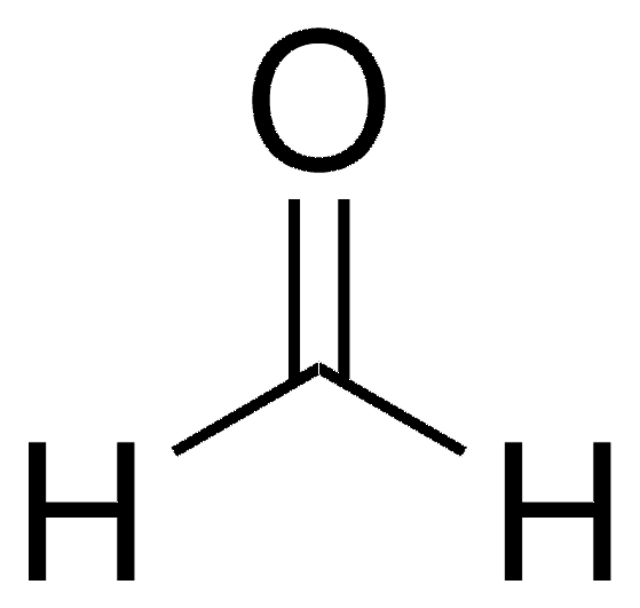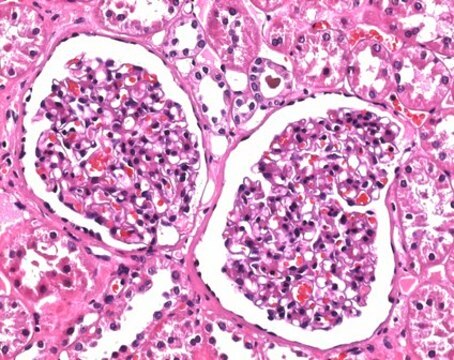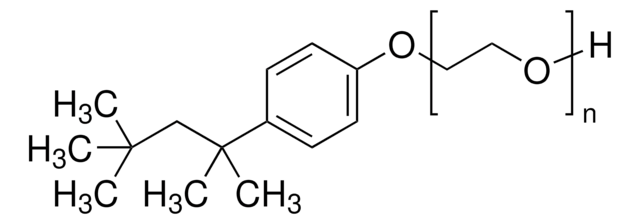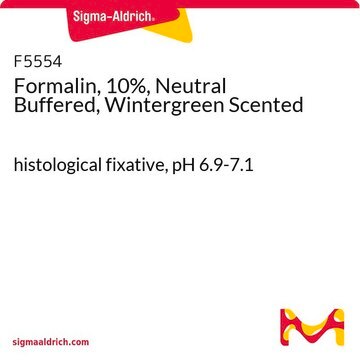HT5012
Formalin solution, neutral buffered, 10%
case of 24 × 60 mL, histological tissue fixative
Synonym(s):
Formaldehyde, Methanal
Sign Into View Organizational & Contract Pricing
All Photos(1)
About This Item
Recommended Products
biological source
synthetic
Quality Level
shelf life
Expiry date on the label.
packaging
case of 24 × 60 mL
concentration
10% formalin (approx. 4% formaldehyde)
color
colorless
pH
6.90-7.10
density
1.080 g/cm3
application(s)
hematology
histology
storage temp.
room temp
InChI
1S/CH2O/c1-2/h1H2
InChI key
WSFSSNUMVMOOMR-UHFFFAOYSA-N
Looking for similar products? Visit Product Comparison Guide
Related Categories
General description
Formalin solution (10%, neutral buffered) is a widely used fixative for samples processed for light microscopy. It requires a relatively short period of fixation. It is suitable for the long-term storage of tissue. Once properly fixed, the tissue should be able to withstand the subsequent stages of tissue processing or staining.
Application
Formalin solution (neutral buffered, 10%) has been popularly used as a general-purpose histological fixative to fix tissue samples.
Popular general purpose histological fixative.
Packaging
Case containers are polypropylene with white leak-proof lids and are partially prefilled with 10% NBF.
Physical form
Neutral buffered solution
Certificates of Analysis (COA)
Search for Certificates of Analysis (COA) by entering the products Lot/Batch Number. Lot and Batch Numbers can be found on a product’s label following the words ‘Lot’ or ‘Batch’.
Already Own This Product?
Find documentation for the products that you have recently purchased in the Document Library.
Customers Also Viewed
Tracking Endocytosis and Intracellular Trafficking of Epitope-tagged Syntaxin 3 by Antibody Feeding in Live, Polarized MDCK Cells.
Giovannone A J, et al.
Molecular Biology of the Cell (2017)
Dermatophytes activate skin keratinocytes via MAPK signaling and induce immune responses.
Achterman R R, et al.
Infection and Immunity, IAI-02776 (2015)
Adam D Pfefferle et al.
Disease models & mechanisms, 12(7) (2019-06-20)
The Wnt gene family encodes an evolutionarily conserved group of proteins that regulate cell growth, differentiation and stem cell self-renewal. Aberrant Wnt signaling in human breast tumors has been proposed as a driver of tumorigenesis, especially in the basal-like tumor
Erika A Crane et al.
Bioorganic & medicinal chemistry, 27(12), 2508-2520 (2019-04-02)
To identify new potential therapeutic targets for neurodegenerative diseases, we initiated activity-based protein profiling studies with withanolide A (WitA), a known neuritogenic constituent of Withania somnifera root with unknown mechanism of action. Molecular probes were designed and synthesized, and led
Hiroyuki Nagashima et al.
Immunity, 51(4), 682-695 (2019-07-30)
Innate lymphocytes maintain tissue homeostasis at mucosal barriers, with group 2 innate lymphoid cells (ILC2s) producing type 2 cytokines and controlling helminth infection. While the molecular understanding of ILC2 responses has advanced, the complexity of microenvironmental factors impacting ILC2s is
Our team of scientists has experience in all areas of research including Life Science, Material Science, Chemical Synthesis, Chromatography, Analytical and many others.
Contact Technical Service



